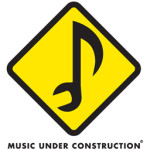You can learn a lot from writing tunes. It doesn’t matter if you think you can or not. Just do it! Allow yourself to write a few  bad ones before you make a gem of a tune.
bad ones before you make a gem of a tune.
Here’s why you should try writing a tune:
- It’s fun.
- It’s easier than you think (see below).
- You get a better sense of how tunes are constructed, by phrase and part.
- You learn a lot about why tunes are written down the way they are, and why there’s always more to a tune than can be written.
- You get to name your tunes after somebody or something important to you (or name it something silly).
- You learn about how music is written down.
Here’s how:
1. First just pick a random few notes, say six or eight, to play or sing. Adjust them until you can sing or play the same sequence three times. Walk or march or tap your toe to your notes. If you can feel four beats you have a phrase.
2. Answer that phrase with another one of the same length. You might start higher, or lower, than the first phrase. You might mirror or parallel the way the first phrase travels up and down.
3. Then come back and play the first phrase again.
4. Finish by playing the second phrase but ending it better.
We could talk about keys and having the second phrase not resolve, and the ending phrase resolve to the key, but none of that is necessary. If you follow the steps above and can play or sing your four phrases the same way multiple times, you have a tune. Often this is half a tune, and you can make another half by simply replacing the first phrase with a new idea, keeping the other phrases intact.
All of this has to be tried and heard with your ears to make it happen. To some this will seem simplistic, to others, it will seem all words and no action. Some will think it impossible. But just give it a try, even by humming in the shower. The main thing is that you can sing your first phrase the same way again.
I’ve tried this process with all levels of players. It’s hard to simply verbalize here, much easier to actually do it, so give it a try!
Warning: if the tune sounds any good, you might presume it’s not original. Who cares? Just play it and enjoy it (and name it!). Write the tune first, ask questions later.
Writing it down is a separate task, also a good experience, but describing it verbally can be difficult and confusing. Look at other tunes for reference. If you have a Finger Finder, you can figure out the key signature of your tune. Often the note it ends on is the key of the tune, but not always. Looking carefully at other written music will show you that the treble clef goes at the start of each line; the key signature comes next; and on the first line only, the time signature is shown.
What time signature do you use? If it’s a quick tune it’s probably a jig (6/8) or reel (2/2). Both have 2 beats in a measure and 2 measures in a phrase. See if you can get help from a musician, but if not, it won’t hurt to explore as you can. The first 4-beat phrase that you put together is likely to be two measures. If each beat can be played with 4 quick notes it’s a reel, if 3 it’s a jig. For other tunes, you’ll need to sing it or play it many times while walking naturally or tapping your toe to feel your natural pulse. You could go through a process of marking the beat notes and then figuring out the subdivisions to work out the time signature, or you could compare the rhythm of your tune to another tune that’s been written down, so you can copy its timing.
As you write the tune down, you’ll have to think about pickup notes — notes that lead into the beats, and about how to write endings. Once again, it’s not so difficult to do but can be confusing to describe. If you don’t have help from a musician, then the best way to figure it out is to copy existing tunes that have the same rhythmic and note patterns as yours.
The main thing is to sing or play your tune or half tune consistently, and enjoy it.
Then you can start in on the hardest part of all: giving it a title!
© 2016 Ed Pearlman